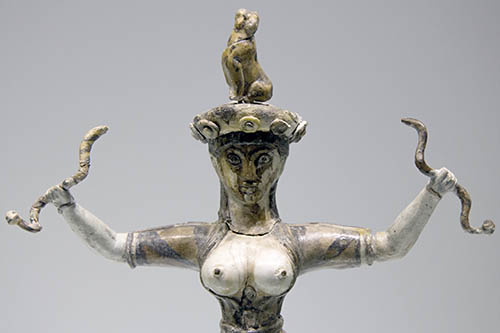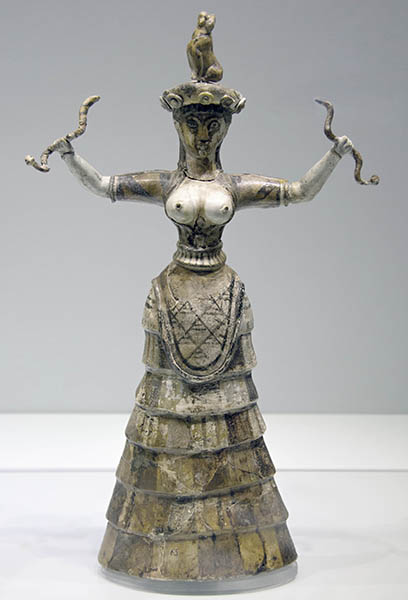Describe and Analyze the Snake Goddess
This act of snake-smiting gender-switching made Tiresias something of a celebrity among the gods so that the goddess Hera called upon Tiresias to intervene in an argument she was having with the god Zeus. The Snake Goddess holds a serpent in each manus.
The theory of the sculptures.

. The actual representation of the Snake Goddess is unknown. The Snake Goddess a voluptuous divine figure with bare breasts and snakes in both hands is one of the most well known female deitys and faïence figurines in Minoan culture Patron. The Snake Goddess as originally excavated lacked a head and half of her left arm.
It also symbolizes immortality as it was thought to shed its skin indefinitely. The distinctive look of the figurines long flaring skirts opened bodices carefully arranged hair with distinctive headdresses and the snakes as accoutrements persists in dominating. It is the connection to the fertile earth and to the underworld.
In 1903 British archaeologist Arthur Evans found the faïence figurine which is known as The Snake Goddess in Minoan archaeological sites in Crete. Hans Georg Wunderlich related the snake goddess with the Phoenician Astarte virgin daughter. Minoan Snake Goddess ca.
The faïence figurine was made between 1600-1580 BCE and the creator remains unknown. It was found at a Minoan archaeological site in Crete. Today little is known about the actual representation of the faïence figurine however evidence supports that The Snake Goddess symbolizes fertility holiness and life and death Flamee.
Choose from 500 different sets of content analysis flashcards on Quizlet. The statuette is composed of faience which is a low-fired glasslike silicate. Hera and Zeus disagreed over who enjoyed sex more.
Wears a chapeau with a sitting cat on top and has exposed bare chests Witcombe The fact that she is depicted partly bare. In 1903 Sir Arthur Evans excavating at the palace of Knossos on the island of Crete discovered fragments of faience statuettes depicting female figures holding snakes. Barry Powell suggested that the snake goddess reduced in legend into a folklore heroine was Ariadne whose name might mean utterly pure or the very holy one who is often depicted surrounded by Maenads and satyrs.
To identify the Snake Goddess as a fertility deity is to impose upon it an interpretation that is so broad as to be virtually meaningless. What is the meaning of the The Snake Goddess. On the other hand Athena wore a snake finged poncho or aegis and the Minoan Snake Goddess is a divine figure holding two snakes in her hand.
This is still the symbol of the medical profession the. This is Kenneth Lapatins startling conclusion in Mysteries of the Snake Goddess-a brilliant investigation into the true origins of the celebrated Bronze Age artifact and into the fascinating world of archaeologists adventurers and artisans that converged in Crete at the turn of the twentieth century. How tall was the snake goddess.
With her chests uncovered is interpreted as a mark of. What is the snake goddess made of. Two of these statuettes were extensively restored and identified by Evans as a Mother Goddess and a Priestess.
The figure stands bare chested with the hands. Other examples of this motif have since been discovered reinforcing the idea that the small sculpture portrays a deity of some kind. The serpent is a totem of the cycles of life death and rebirth and the seasons.
Snakes were associated with their power to kill but were positive attributes. The unity of the Great Goddess becomes divided in Greek mythology. The complete right arm held a short wavy striped stick which Evans interpreted as a snake.
This was in some measure to match the other nearly complete figurine found in the Temple Repositories which clearly had snakes slithering up both of her arms. At the same time it also effectively stifles consideration of it having a more specific meaning and functioning in a. The faience figurine identified as Snake Goddess was discovered in 1903 by Arthur Evans in the Temple Repositories of the Knossos palace in the island of Crete in Greece.
While the idols true function is. While the Minoan Snake Goddess is one of the most reproduced and familiar images in the art historical canon her functionand indeed her very essencecontinues to be shaped by the man who coined the term Minoan and discovered the site in which she and her sisters lay for generations undisturbed. Minoan Snake Goddess Minoan Snake Goddess This 3500-year-old figurine depicts a woman with bare breasts holding a snake in each of her raised hands.
These figures became iconic images of Minoan civilization as soon as they were published and ever. This sculpture is relatively small about 1 1 12 high from its base and is from the palace of Knossos. Discovered in 1903 by British archaeologist Sir Arthur Evans at The Temple Repositories The Snake Goddess dates back to approximately 1600 BCE Evans 495.
At the Palace of Knossos by archaeologist Arthur Evans and dated to the Minoan civilization c. I chose to analyze a sculpture named Snake Goddess from the ancient Minoan civilization dating back to 1600 BCE. To describe the size of the snake goddess.
Aclepius the god of healing has as a symbol a snake around a rod. The Snake Goddess in Minoan Culture. What is the term used to describe how the snake goddess holds the snake in her hand.
Their elegant fashionable costumes their physical gracefulness their sensitive yet forthright personalities their sophisticated tastes and love of luxury their refined manners and worldly. Learn content analysis with free interactive flashcards. She is dressed in the typical Minoan clothes with a long skirt and a tight open bodice that leaves her breasts uncovered and she holds a snake in each hand.
This figurine of a woman holding a snake in either hand with a cat sitting on top of her head was discovered by Arthur Evans in the original excavation of the Pallace of Knossos. Part of the attraction of the figurines is that they can be interpreted as embodying many of the perceived and admired characteristics of the Minoans. When Sir Arthur Evans concluded.
However a majority of perceptions would all agree that the Snake Goddess is an important female deity in Minoan civilization. Figurines typically referred to as Snake Goddesses. The Snake Goddess Analysis.

Snake Goddess Article Minoan Khan Academy

0 Response to "Describe and Analyze the Snake Goddess"
Post a Comment